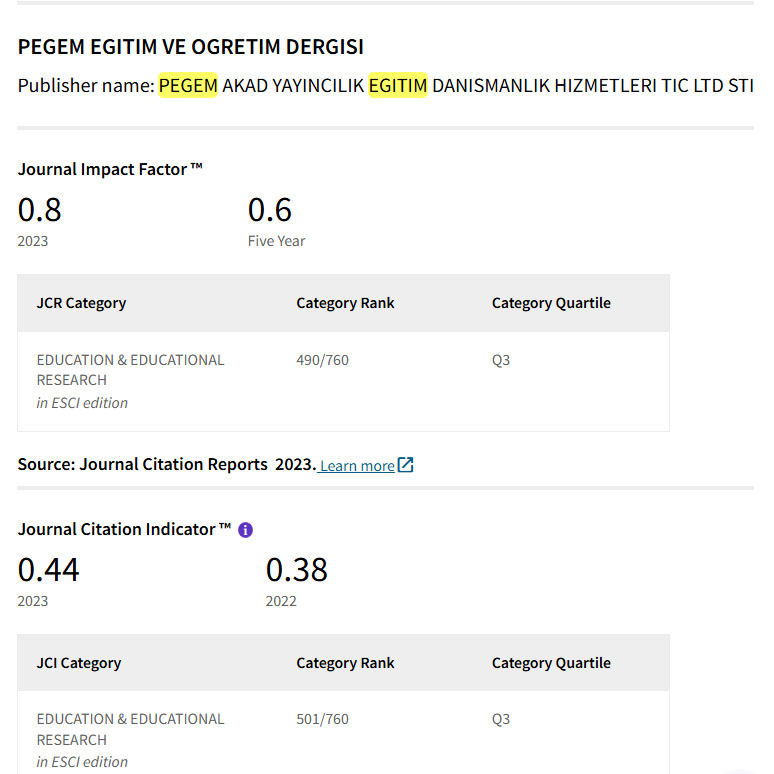An investigation of the faculty members’ practice excitement styles during distance learning
DOI:
https://doi.org/10.47750/pegegog.12.01.04Keywords:
Thrill Styles, Faculty Members, Distance Education, , University StudentsAbstract
This study aimed to identify the degree to which faculty members practice thrill styles in distance education from the students’ perspective. The study sample consisted of (298) randomly selected male and female students who enrolled in bachelor’s and master’s programs in various colleges at Amman Arab University, Jordan. To achieve the study’s goal- which followed the descriptive approach, the researchers prepared a scale to reveal the degree to which faculty members practice thrill styles in distance university education. After verifying its validity and reliability, it was applied to the study sample. The results showed that the degree to which faculty members practice thrill styles during distance university education was moderate. Also, There were no statistically significant differences in practicing thrill styles due to gender, faculty, and academic program variables.
Downloads
References
Abu Daf, Mahmoud (2015). The degree to which high school teachers practice reinforcement and excitement styles, as mentioned in the prophet Muhammad Sunnah. Journal of the Islamic University of Educational and Psychological Studies. 23 (3), 52-25.
Al Jarrah, Abdel Nasser, alMufleh, Muhammad, Al Rabie'e, Faisal and Gawanemeh, Mamoun (2014). The impact of teaching using educational software in improving students’ motivation to learn mathematics among second-grade students in Jordan, The Jordanian Journal of Educational Sciences, 10 (3), 261-274.
Al-Hudayris, Mazen Muhammad (2019). The styles followed by the secondary school teacher and its relation to increasing the learner’s motivation towards learning, The Arab Journal of Scientific Publishing. Jordan, (13), 65-93.
Elmahdi, Ismail, Al-Hattami, Abdulghani & Fawzi, Hala (2018). Using Technology for Formative Assessment to Improve Students’ Learning. TOJET: The Turkish Online Journal of Educational Technology (17) 2, 182-188.
Frenzel, Anne, Taxer, Jamie Schwab, Carolin and Kuhbandner, Christof (2019), “Independent and joint effects of teacher enthusiasm and motivation on student motivation and experiences: A field experiment,” Motivation and Emotion, ( 43)2, 255–265,
Ghobari, Thaer, and Abu Shairah, Khaled (2009) The degree to which general secondary school teachers practice strategies to stimulate curiosity with their students from students’ perspectives in light of some variables, governorate of Irbid. Studies, Educational Sciences, (36), 398-411
Jassim, Suhaib, (2015). The degree to which Islamic education teachers practice thrill and excitement styles in teaching the Holy Qur’an from their perspective in the upper elementary stage in Amman. Unpublished master’s thesis, Al al-Bayt University
Keller, Melanie, Hoy,Anita,Goetz,Thomas, & Eva, Frenzel. (2016), “Teacher enthusiasm: Reviewing and redefining a complex construct,” Educational Psychology Review, (28)4, 743-769.
Kilbanov, Olga, Dolder, Christian, Anderson, Kevin, & Kehr, Heather (2018). Impact of Distance Education via Interactive Videoconference and Satisfaction. Advances in Physiology Education. 42(1):21-25
Lazarides, R., and A. Dicke (2019), “Dynamics of classroom motivation: Teacher enthusiasm and the development of math interest and teacher support,” Learning and Instruction, 160, 126-137.
LLazarides, R., H. Gaspard and A. Dicke (2019), “Dynamics of classroom motivation: Teacher enthusiasm and the development of math interest and teacher support,” Learning and Instruction, )160(. 126-137,
retrieved http://dx.doi.org/10.1016/J.LEARNINSTRUC.2018.01.012.
Lynch, Matthew(2016). Excitement Equals Excellence: How Educators can Rile up Student Motivation. Retrieved from https://www.theedadvocate.org/excitement-equals-excellence-educators-can-rile-student-motivation/ 1/10/2020
Saadeh, Judeh Ahmed (2018). Modern Teaching Strategies. Amman, Daar al Maseera
Sadeghi, Manijeh(2019). classroom to distance learning: advantages and limitations. International Journal of Research in English Education 4:1 (80-88)
Sujit Kumar Basak, Marguerite Wotto and Be´langer.(2018). E-learning, M-learning, and D-learning: Conceptual definition and comparative analysis, E-Learning and Digital Media, 15(4) 191–216
UNESCO (2002) Open and distance learning-Trends, policy and strategy considerations, Paris, FR: UNESCO
Downloads
Published
How to Cite
Issue
Section
License
Copyright (c) 2021 Pegem Journal of Education and Instruction

This work is licensed under a Creative Commons Attribution-NonCommercial 4.0 International License.
Attribution — You must give appropriate credit, provide a link to the license, and indicate if changes were made. You may do so in any reasonable manner, but not in any way that suggests the licensor endorses you or your use.
NonCommercial — You may not use the material for commercial purposes.
No additional restrictions — You may not apply legal terms or technological measures that legally restrict others from doing anything the license permits.




